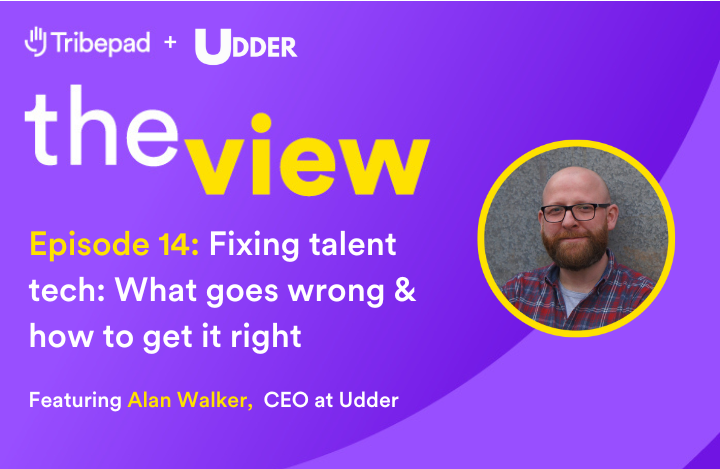Implementation is where too many software projects stall. Alan Walker, CEO of Udder, has been involved with 300+ talent tech roll-outs. He shares four common recruitment software implementation mistakes and how to solve them. Because new tech should mean better hiring, not bigger headaches.
Implementing new recruitment software should be exciting. A chance to supercharge efficiency, elevate your candidate experience, and finally get your TA function firing on all cylinders.
But too often, implementation is where good intentions go to die.
Projects drag. Features languish unused. ROI never materialises. Questions pile onto questions onto questions, leading to blame and pointed fingers.
Alan Walker – CEO of HR technology consulting firm Udder – has overseen more than 300 recruitment software implementations, so he’s seen lots of what can go wrong on the path to getting it right.
He joined us for episode 14 of The View, to share how TA leaders can get it right faster.

Lessons from 300+ implementations: 4 mistakes and how to solve them
Often recruitment teams buy software and then implement it badly, so what they get is not what they bought. Usually that’s not a bad buying decision, or down to vendor support. It’s often down to missteps from the HR leader. Avoidable missteps.
Even the most experienced TA leaders have probably only managed three or four major recruitment software implementations in their career. If that.
Udder have delivered more than 300, so they’ve got a great viewpoint to see patterns. Here’s what Alan sees go wrong most often, and how to steer around those potholes before the wheels fall off.
Pothole #1: New platform; same problems
Buying new recruitment software is a time to reset. Implementing a new ATS to do everything exactly as you did before is pointless. Yes, you might do it slightly quicker. Yes, the interface might look slightly sexier. Yes, your team might enjoy using it slightly more. But the end results are going to be very similar if you’re just doing exactly what you always did.
When teams invest huge resource into new tech but none into process redesign, they’re stuck with:
- Recruiters still waiting on endless approvals
- Hiring managers still ignoring the system
- Candidates still hitting unnecessary friction
- Leaders still searching for concrete results
If you’re buying shiny new software but running the same old processes through it, you’re spending a lot of money for a jazzier version of the same frustrations. And a near-guarantee you’ll need to go to market again when your contract ends.
Stepping around it:
Treat this as an opportunity to reset. Analyse every step of your recruitment process – from requisition to onboarding – and ask: does this add value? Could it be simplified, automated, or removed?
Challenge your sacred process cows that only exist “because that’s how we’ve always done it”. Implementation is your chance to strip out complexity, not hardwire it in.
Pothole #2: Mis-scoped change
Teams need to really understand the journey they’re embarking on, from where they are now to their vision. It’s not as simple as just buying a bit of tech that does all these wonderful new things. There might be process changes. There might be people changes. There might be changes to your total operating model. You need to understand all those, rather than diving straight in.
Change doesn’t have to happen overnight. It’s about having a plan. It’s okay to start using 30% or 40%, of a platform as long as you have a roadmap to move to 80% or 90% over time.
Another common recruitment software implementation mistake is ineffective project scoping, leaving teams languishing without the people or time to deliver what was promised. Especially right now, as feeling-the-pinch teams are overburdened with business-as-usual.
Yes, new tech is an opportunity to deliver true change. But when project scope balloons and the new ATS is supposed to fix everything, everywhere, all at once, the project’s likely to choke on complexity. Leaving you with:
- Overblown projects that try to fix everything and fix little
- Chaotic seat-of-your-pants change lacing coherent direction
- Recruiters and managers overwhelmed by too much change
- Stakeholders frustrated at lack of progress
Stepping around it:
Think in an iterative way. Define what must change now and what can wait, then write a roadmap you actually stick to. Break change into achievable phases so each stage delivers visible value, without overwhelming the organisation.
Phased adoption spreads workload, reduces resistance, and builds momentum. So you don’t end up buying a lovely new system only for half the features to sit on the shelf gathering dust.
Pothole #3: Buying for the market, not your business
Take a long, cold, hard look in the mirror before choosing new tech. Not everyone’s Google and not everyone wants to be Google.
Are you genuinely as sophisticated and complicated as you think? What are your budgetary constraints? Your resource constraints? What’s your art of the possible? What can you achieve? What’s your best possible approach? Teams need to act in the context of their organisation.
Many teams start researching recruitment software by looking exclusively at the market. When requirements are copied from competitors or built on buzzwords instead of evidence, teams are often stuck with:
- An A-Z of features that don’t solve real problems
- An overwhelming platform that’s too complex for how you work
- Recruiters under-using expensive functionality
- Leaders asking why adoption is low and ROI is invisible
If you’re buying for the market instead of your business, you’re investing in someone else’s priorities. And paying the price in wasted spend, wasted time and oodles of frustration.
Stepping around it:
Start with discovery. Map your bottlenecks, candidate drop-offs, recruiter frustrations, and hiring manager pain points. Then shape your shopping list around solving those problems in your context – budget, headcount, culture, appetite for change. Not someone else’s.
Start with evidence, not wishlists and assumptions.
Pothole #4: A flimsy business case
Ultimately, leadership cares about numbers with a pound sign, dollar sign, or euro sign in front of them. Soft measures like ‘better candidate experience’ are important, but they won’t win you resource on their own. You’ve got to translate those benefits into hard commercial outcomes.
What’s it going to bring to the bottom line? Is it saving me money? Is it making me money? Is it making me more productive?
A strong business case isn’t just about securing investment. It’s also crucial to implementation. When there’s not a compelling ROI story driving progress, projects wind-up underpowered:
- Budgets too thin to fund dedicated project managers or consultancy support
- Recruiters juggling BAU and implementation, with neither done well
- Leadership focus and support drifting as other initiatives take priority
- Resistance from stakeholders who can’t see why change is worth the pain
Buying new software without clear ROI goals is a near-guarantee of missed deadlines, half-baked adoption, and systems that underdeliver.
Stepping around it:
Build a business case that’s strong enough not only to secure sign-off but to sustain the project through delivery. Show how faster go-live cuts wasted licence fees; how streamlined workflows free recruiter capacity; how improved candidate experience reduces spend.
The stronger the evidence, the easier it is to win leadership backing, fund proper resource, and push through the process change needed to make implementation succeed.
Articulating value is also the critical skill for recruitment teams to build in the age of AI, as Indeed’s Matt Burney chatted to us about recently.
Download our guide to building a business case here.
Pulling it together
Implementing new recruitment software is one of the most powerful levers TA leaders have to improve efficiency, reduce cost, speed-up hiring, and deliver a recruitment experience everyone enjoys.
But without disciplined execution, projects can slip into wasted time, wasted money, and wasted credibility.
The difference isn’t just the platform. It’s how you implement. The lesson from 300+ implementations?
- Take the opportunity to reset your processes
- Scope implementation realistically
- Understand your true organisational context
- Put ROI front and centre from the get-go
That’s how implementation becomes not just a system switch but a catalyst for real change. For fairer, faster, better recruitment for everyone.
–
Tribepad is the trusted tech ally to smart(er) recruiters everywhere. Our talent acquisition software is a springboard for fairer, faster, better recruitment for everyone.
Trusted by organisations like the Greggs, Tesco, NHS Professionals, and Subway, 30-million people in 16 languages use Tribepad.



